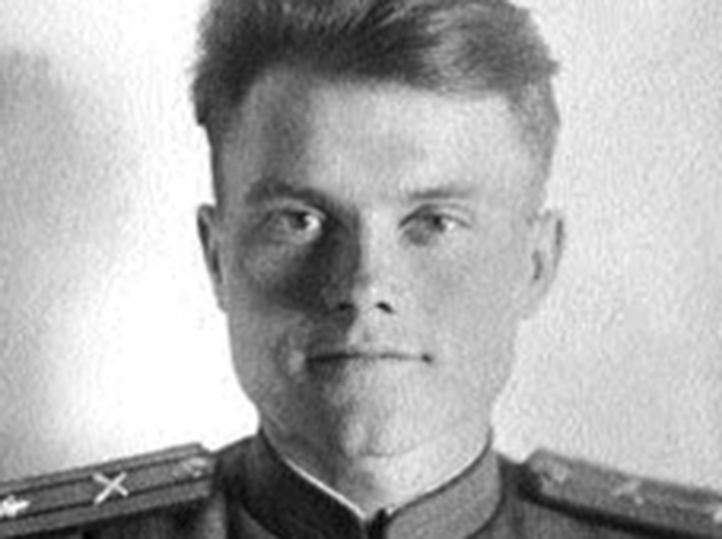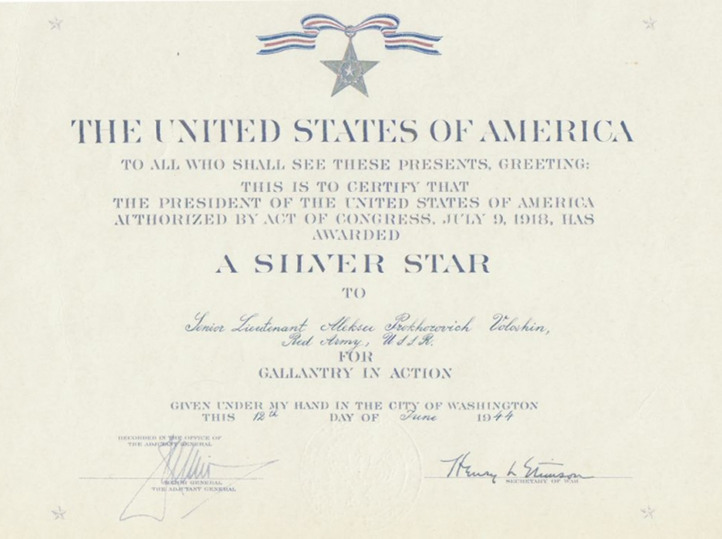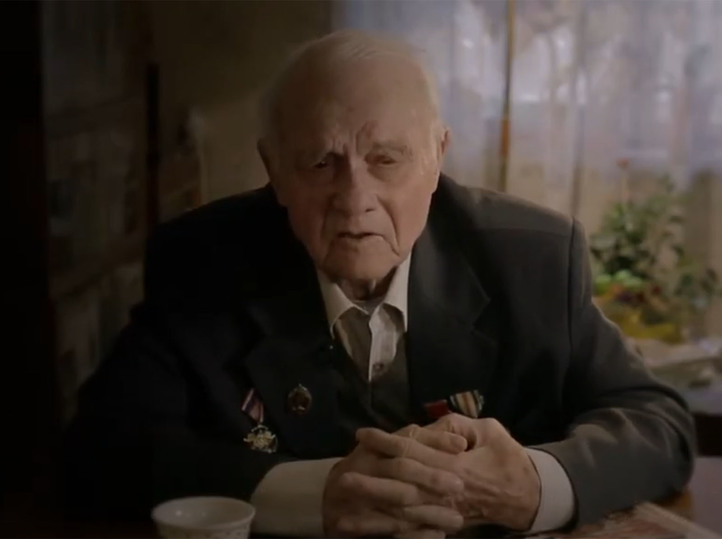Cavalier of two Stars: “I received the most terrible impressions during the defense of Stalingrad”
[ad_1]
Aleksey Voloshin, a 21-year-old student at one of the Odessa technical institutes, went to the front in July 1941 as a volunteer. The military registration and enlistment office stated categorically: “We must go to war, otherwise the war will end.”
The guy, like many others then, sincerely believed that the victorious Red Army would quickly defeat the Nazis who attacked the country. However, such hopes were not destined to come true. Ahead of Alexei were four most difficult years of military suffering.
The techie student was immediately sent to the artillery school, in early February 1942 he received two lieutenant “head over heels” on his buttonholes. The first place of service in the active army was a howitzer regiment on the South-Western Front, but it didn’t take long to fight there. In March, Voloshin was wounded, and after the hospital he ended up in completely different places: he served as an adjutant to the commander of the 1104th cannon artillery regiment, which was being formed in Stalingrad.
However, Alexei did not stay at the headquarters – he wanted to “really” beat the Nazis. Already in July, a battery of 152-mm howitzers, commanded by Lieutenant Voloshin, distinguished himself in a battle on the Myshkova River.
Alexey Prokhorovich himself later recalled: “I knocked out my first tank on the Myshkovo River. How did it happen? Noticing the accumulation of Germans, he begged four shells from the regiment commander (our artillerymen then experienced a great shortage of ammunition. – HELL.). I prepared the data for firing and covered the enemy with these shells. One of them hit the tank, which caught fire. … It was the first tank knocked out by the regiment … “
By the end of the summer, the lieutenant was transferred to a new duty station – to the 271st rifle regiment of the 10th division of the internal troops of the NKVD, based in Stalingrad itself. Here he commanded a battery of 76 mm guns.
The Chekist division turned out to be among those of our military formations, which, having formed a defense line just a few kilometers from the city center, took on the brutal blow of the Wehrmacht units advancing from the southwest, from the Don. This thin chain of fighters and commanders, reinforced only by regimental and divisional artillery, managed to delay the enemy and prevent him from capturing the city from a raid. And then, suffering heavy losses, they retreated slowly, clinging to any ravines, hills, ruins of a building suitable for battle … This eventually made it possible to create new defense lines behind their backs, pulling additional troops there.
Voloshin remembered those battles for the rest of his life: “Actually, I got the most terrible impressions from the war during the defense of Stalingrad. The advantage of the Germans was overwhelming. Their planes literally went over their heads … Our aviation is not there, all anti-aircraft artillery died on direct fire. Therefore, if you find some kind of hole, you press yourself into the ground – you want to push through it with your chest. And this despite the fact that I was wounded in mid-September and did not fight in these terrible, super-terrible defensive battles, where our entire division died. True, during the time that I was in it, I once went into a bayonet attack.

Like this. In the Elshanka area, where at that time there was the southern outskirts of Stalingrad, in the complete absence of shells, when the guns were useless, the young commander found only one opportunity: to lead the surviving soldiers of his artillery crews, like ordinary infantrymen, against the Nazis and throw them back. “There were 16 people left in the battery, they went into a bayonet attack – eight remained.”
In that desperate night battle, Alexei himself was lucky to survive, but a few days later, an enemy fragment still overtook him.
“I was wounded in the leg just above the knee. The ferry crossed the Volga. They said that when the division was taken to the right bank, 191 people out of ten thousand who entered the battle remained in the ranks.
After being seriously wounded in the autumn of 1942 (doctors almost had to amputate the young guy’s leg), Voloshin was treated for a long time and only in the middle of winter returned to his division, which by that time had already been reorganized and received a different, honorary designation: 181st Stalingradskaya Order of Lenin Division.
Together with the 271st Nizhnevolzhsky Regiment of the division, which included Voloshin 76-millimeters, the officer took part in the battle on the Kursk Bulge. In these battles, the gunners of the battery knocked out three German tanks. The combat account was replenished in the autumn of 1943, during the assault on Chernigov, with several more destroyed enemy armored vehicles.
But the battles during the crossing of the Dnieper at the end of September turned out to be especially fruitful. One day, the battery, whose actions were directly supervised by Alexei Voloshin, knocked out 11 fascist tanks, including several heavy Tiger vehicles. When he was asked how this was possible, Alexei Prokhorovich explained simply: “Probably out of fear: I saw the Tigers for the first time! He sent two cannons at each and rushed back and forth, checking the correctness of the aiming … Otherwise, where would my guys and I be? In that world? .. “
After that, Senior Lieutenant Alexei Voloshin became known in the army as “the fighter of the fascist Tigers.” It was for the Dnieper battles that he soon received the title of Hero of the Soviet Union.
And a few months later, another one of his awards took place – quite unique. In June 1944, US President Roosevelt, by his decree, awarded four Soviet junior commanders with one of the highest American distinctions – the Silver Star medal. In accordance with the wishes of Mr. President, among the elected were one officer from different branches of the ground forces: an infantryman, a tankman, a sapper and an artilleryman. Of the many distinguished representatives of the “Queen of the Fields”, the choice of the owner of the White House stopped precisely on the candidacy of Voloshin. Apparently, Roosevelt was impressed by the combat score of this young gunner: by that time, commanding a battery, and in some cases even personally firing at the enemy, he had knocked out 20 German tanks.

The award diploma says: “Everyone who sees this award should greet and honor this person. It is hereby acknowledged that the President of the United States of America has awarded the Silver Star to Lieutenant Aleksey Prokhorovich Voloshin, Red Army, USSR, for bravery in hostilities. June 12, 1944″.
The overseas award found its hero only in the autumn of 1944. The “Silver Star” was solemnly presented to Voloshin and two other chosen ones in the Kremlin by the representative of the President of the United States Hopkins, US Ambassador Harriman and the US military attaches.
In 1944, at the personal suggestion of the Chief Marshal of Artillery Nikolai Nikolaevich Voronov, Alexei Voloshin entered the Artillery Academy of the Red Army. A year later, in June 1945, he – already in the rank of major – became a participant in the famous Victory Parade on Red Square, was the standard bearer of the academy.

On account of Alexei Prokhorovich and another impressive achievement. He lived for 100 years – and until his death in the summer of 2020, he was among the last few Heroes of the Soviet Union remaining with us who received the Gold Star during the Great Patriotic War …
[ad_2]
Source link








